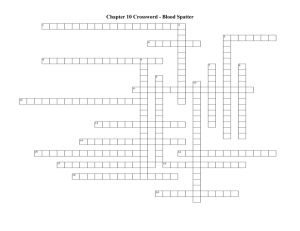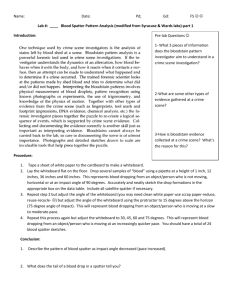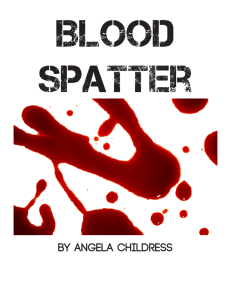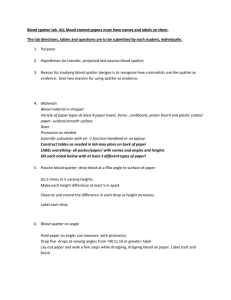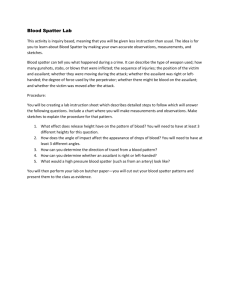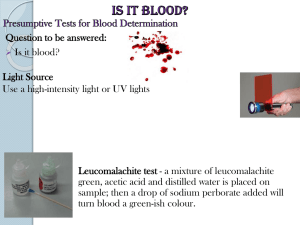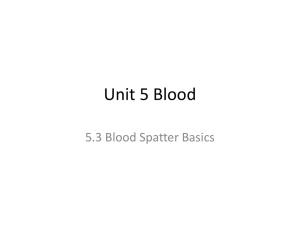Blood Spatter Analysis
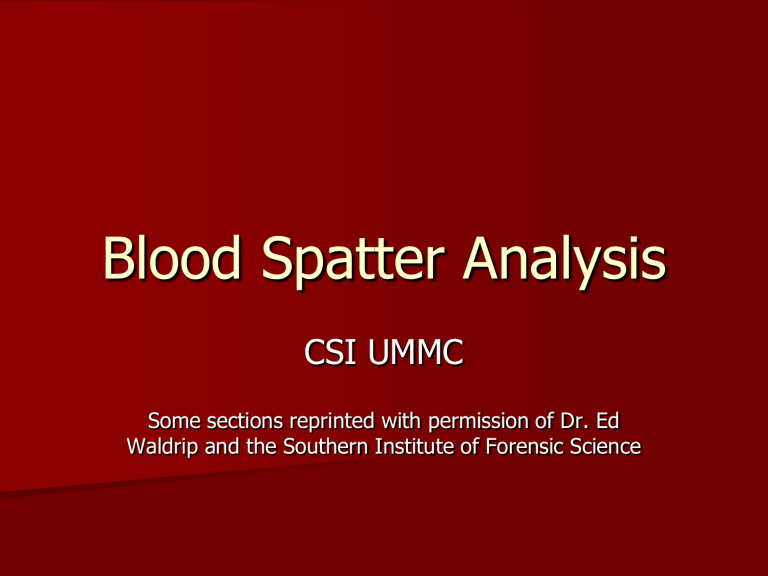
Blood Spatter Analysis
CSI UMMC
Some sections reprinted with permission of Dr. Ed
Waldrip and the Southern Institute of Forensic Science
Blood Pattern Analysis
The use of physics and math to interpret bloodstain patterns within a forensic setting
May show:
1. Activity at scene
2. Number of blows
3. Position of victim and assailant
4. Whether death was immediate or delayed
5. Weapon characteristics
History
1894 - Pitorowski wrote earliest reference to bloodstain pattern analysis
1939 - Balthazard was first to use physical interpretations of stains
1955 - Dr. Paul Kirkused bloodstain pattern interpretation as a defense witness in the Sam Shepherd case
1971 - Professor Herbert MacDonnell promoted bloodstain pattern interpretation as a tool for modern criminalistics
1983 – The International Association of Bloodstain
Pattern Analysis was formed
Basic principles
A free falling drop of blood forms a sphere or ball.
A spherical drop will break
1. When it strikes another object
2. When acted upon by some force
Spatter size is dependent upon
velocity
Low velocity spatter is about 5 ft / second and usually
3 mm or greater in diameter and indicates blood is dripping
Medium velocity spatter is 5 – 25 ft / second with a <3 mm diameter and usually indicates blunt trauma or sharp trauma or it could be cast-off
High velocity spatter is 100+ ft / second with a spatter of < 1 mm indicating gunshot trauma, power tools, an object striking with extreme velocity (airplane prop) or an explosion, may be referred to as fly specks
Determining Location of Blood Source
Direction of travel – tail will point in direction of travel
Angle of impact
1. Vertical drops are circular
2. Drop elongates as angle increases
Measure width and length then calculate angle it struck the surface
Attach string lines to each of the spatters and lines converge at the blood source
Angle of Impact
“The tail tells the tale”
90 degrees –
60 degrees –
30 degrees –
10 degrees –
String Convergence in a 2 Dimensional Plane
Convergence
Cast-off Bloodstains
Arterial Gushing
Calculated point of origin
Closer for high velocity spatter or when stains originate closer to where the spatter occurred
Other Patterns in Blood
Transfer patterns (gun, knife, hand, foot…)
Void patterns (indicating some object was removed or a person was hit by spatter)
Flow patterns (may indicate movement with change in flow)
Drying Time
Drying begins at periphery and proceeds inward
Drying time is affected by
– Surface type
– Amount of blood
– Climatic conditions
Skeletonization
– Partially dry stains leave a ring that outlines original spatter
– The drier the stain, the less skeletonization shown
Clotting Time
Clotting time outside the body ranges from 3 – 15 minutes
Spattered clots indicate that time passed between the initial bleeding and later blows
Coughing of clotted blood may indicate post-injury survival of victim
Group Activity
Obtain the blood solution, dropper, protractor and paper plate
Drop one drop of blood from 3 feet above the plate with the plate at 90 degrees to the dropper
Drop ten more drops in different locations but with each subsequent drop decrease the angle between the dropper and the plate
Record the angles used and observe the drops
Describe what you see


